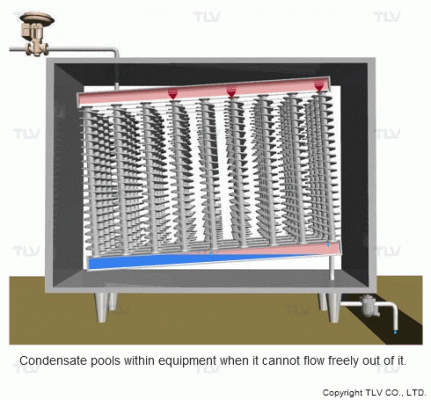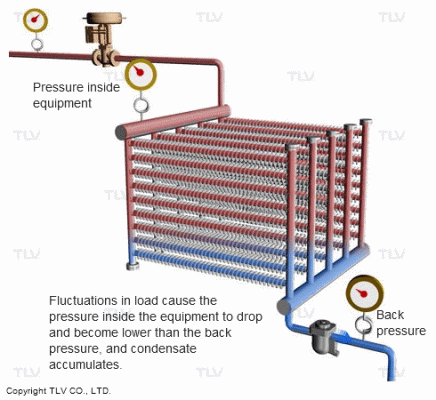What is the phenomenon of water hammer in equipment?
The phenomenon of water hammer in equipment, such as heat exchangers, often originates from the accumulation of condensed water at elevated levels. This can occur even when the equipment is operating stably. When the performance of the heat exchanger declines—usually due to reduced heat exchange efficiency or increased product temperature—the pressure differential between the steam trap’s inlet and outlet no longer appears. This leads to condensed water beginning to accumulate within the equipment shell, known as “stagnation.” Based on reverse pressure, condensed water can fill the shell when the equipment is inactive.

When steam is introduced into areas with a high concentration of condensed water, it will condense rapidly and cause water hammer. Usually, these are minor and short-term impacts, unlike the major impacts commonly seen in steam distribution lines. However, if this phenomenon occurs continuously over an extended period, it can weaken the equipment and lead to sudden failure. This typically occurs when the equipment operates at high pressure, heavy load, or maximum capacity. Therefore, promptly removing condensed water is crucial from a preventive maintenance perspective.
Additionally, there are a range of other factors that can lead to the accumulation of condensed water in the equipment. Causes may relate to design, installation, the construction of the heat exchanger, or a poor condensed water recovery system. To prevent the accumulation of condensed water, it is essential to identify the cause and implement appropriate preventive measures. Similar to steam distribution systems, proper drainage of condensed water and maintaining a stable operating process are two key factors to avoid water hammer in steam-using equipment.
Reasons Leading to Condensate Accumulation in Equipment and Challenging Cases
The cause of condensed water accumulation in equipment can stem from suboptimal design or orientation of the equipment, as well as from operational stagnation.

Inappropriate design or orientation of the equipment

Operational stagnation
A challenging example of dealing with condensed water accumulation is in a single-core heater located at the bottom of a 100-meter high, 13,600-ton oil tank. Due to the slope between the inlet and the outlet being only 1/300 or 1/400—much smaller compared to the standard pipeline slope of 1/100 or 1/200—condensed water does not always flow down by gravity. In such situations, the design of the equipment does not support natural downhill flow, increasing the difficulty in handling the issue.

Stagnation, as mentioned above, is another complex reason, especially in conventional heaters.
To effectively address the phenomenon of water hammer in such situations, one of the notable measures is using steam to push the condensed water out of the equipment and employing vacuum pumps for condensed water recovery.

 Tiếng Việt
Tiếng Việt




